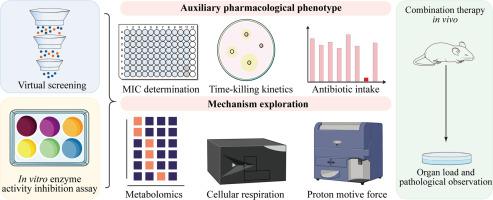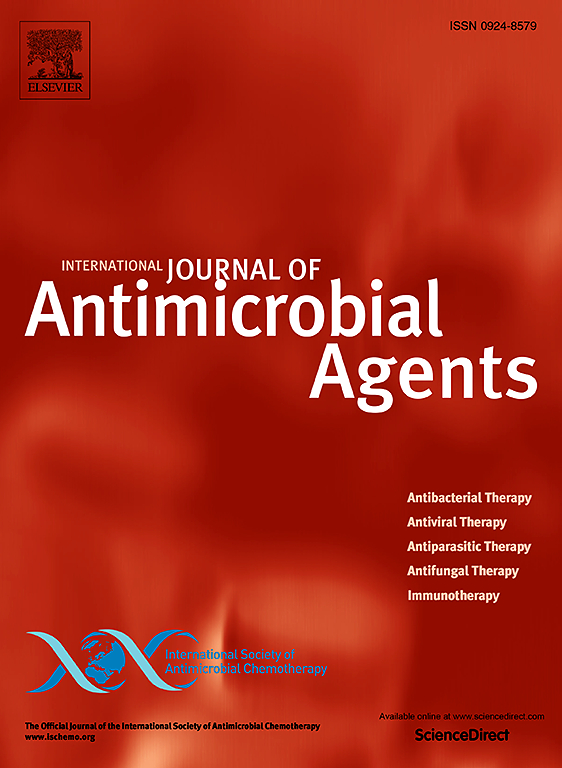Disrupting bacterial metabolism by targeting LDH reverses Streptococcus suis aminoglycoside resistance
IF 4.6
2区 医学
Q1 INFECTIOUS DISEASES
International Journal of Antimicrobial Agents
Pub Date : 2025-08-20
DOI:10.1016/j.ijantimicag.2025.107599
引用次数: 0
Abstract
Background
The emergence of drug-resistant Streptococcus suis (S. suis), driven primarily by antibiotic overuse in veterinary medicine and agriculture practices, threatens global public health. Antibiotic adjuvants that potentiate existing drugs offer a promising strategy to combat resistance.
Methods
We screened two small molecules targeting lactic dehydrogenase of S. suis. Hit compounds panaxadiol (PD) and vitamin D2 (VD2) were evaluated for metabolic modulation via aerobic respiration assays, NADH quantification, proton motive force (PMF) measurements, and metabonomics analysis. Aminoglycoside uptake and bactericidal activity were assessed in vitro and in vivo. All data are presented as mean ± SD from three independent experiments, and significance was determined by unpaired t tests (*P < 0.05, **P < 0.01, ***P < 0.001).
Results
PD and VD2 inhibited S. suis lactic dehydrogenase, suppressing anaerobic metabolism and redirecting pyruvate to the tricarboxylic acid cycle. This shift increased NADH production, amplified PMF, and enhanced uptake of PMF-dependent aminoglycosides. Both compounds synergized with aminoglycosides, significantly improving bactericidal efficacy against S. suis in vitro and in animal models.
Conclusions
Targeting S. suis metabolic pathways with PD or VD2 restores aminoglycoside susceptibility, offering an adjuvant strategy to counter antibiotic resistance.

通过靶向LDH破坏细菌代谢逆转猪链球菌氨基糖苷耐药性。
背景:耐药猪链球菌(S. suis)的出现,主要是由兽医和农业实践中抗生素的过度使用引起的,威胁着全球公共卫生。增强现有药物的抗生素佐剂为对抗耐药性提供了一种有希望的策略。方法:筛选两种靶向猪链球菌乳酸脱氢酶(LDH)的小分子。Hit化合物Panaxadiol (PD)和Vitamin D2 (VD2)通过有氧呼吸测定、NADH定量、质子动力(PMF)测量和代谢组学分析评估其代谢调节作用。体外和体内评估氨基糖苷的摄取和杀菌活性。所有数据均以三个独立实验的平均值±SD表示,采用非配对t检验确定显著性(*p < 0.05, **p < 0.01, ***p < 0.001)。结果:PD和VD2抑制猪链球菌LDH,抑制厌氧代谢,将丙酮酸重定向到三羧酸循环。这种转变增加了NADH的产生,放大了PMF,并增强了PMF依赖性氨基糖苷的摄取。这两种化合物与氨基糖苷协同作用,在体外和动物模型中显著提高了对猪链球菌的杀菌效果。结论:用PD或VD2靶向猪链球菌代谢途径可恢复氨基糖苷敏感性,为对抗抗生素耐药性提供了一种辅助策略。
本文章由计算机程序翻译,如有差异,请以英文原文为准。
求助全文
约1分钟内获得全文
求助全文
来源期刊
CiteScore
21.60
自引率
0.90%
发文量
176
审稿时长
36 days
期刊介绍:
The International Journal of Antimicrobial Agents is a peer-reviewed publication offering comprehensive and current reference information on the physical, pharmacological, in vitro, and clinical properties of individual antimicrobial agents, covering antiviral, antiparasitic, antibacterial, and antifungal agents. The journal not only communicates new trends and developments through authoritative review articles but also addresses the critical issue of antimicrobial resistance, both in hospital and community settings. Published content includes solicited reviews by leading experts and high-quality original research papers in the specified fields.

 求助内容:
求助内容: 应助结果提醒方式:
应助结果提醒方式:


